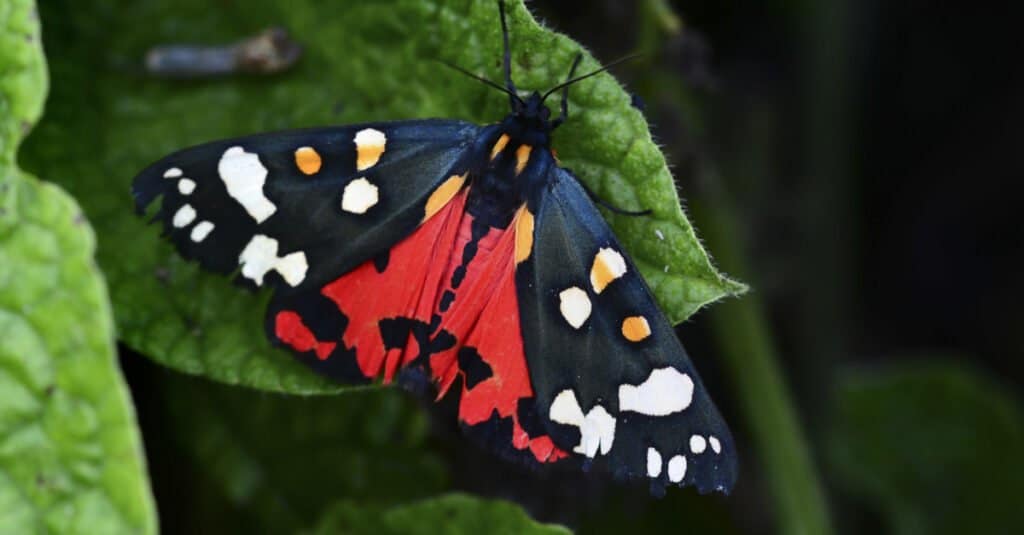Tiger Moth
.jumbotron {
background-image: url(“https://a-z-animals.com/media/2021/07/Pair-of-Tiger-Moths-400×300.jpg”);
}
}
@media only screen and (min-width: 641px) and (max-width: 920px) {
.jumbotron {
background-image: url(“https://a-z-animals.com/media/2021/07/Pair-of-Tiger-Moths-470×370.jpg”);
}
}
@media only screen and (min-width: 921px) {
.jumbotron {
background-image: url(“https://a-z-animals.com/media/2021/07/Pair-of-Tiger-Moths.jpg”);
}
}
Tiger Moth
The bright colors of this moth are a signal to predators that it has a terrible taste.
Tiger Moth Scientific Classification
Read our Complete Guide to Classification of Animals.
Tiger Moth Conservation Status
Tiger Moth Facts
- Name Of Young
- Caterpillar, larva
- Group Behavior
-
- Solitary
- Fun Fact
- The bright colors of this moth are a signal to predators that it has a terrible taste.
- Biggest Threat
- Habitat loss
- Most Distinctive Feature
- Brightly colored pattern on its wings
- Other Name(s)
- Woolly bear (caterpillars)
- Gestation Period
- Eggs hatch in 10 days
- Wingspan
- 1.5-2 inches
- Litter Size
- 50 or more
- Habitat
- Grasslands, forests
- Predators
- Some birds
- Diet
- Herbivore
- Favorite Food
- plants, nectar
- Type
- Insect
- Common Name
- tiger moth
- Number Of Species
- 11000
- Location
- North America, Europe, Central Asia, Northern Asia
This post may contain affiliate links to our partners like Chewy, Amazon, and others. Purchasing through these helps us further the A-Z Animals mission to educate about the world’s species..

Spiders that fly! Fish that walk! And 1000+ more incredible animals. Discover them all for FREE
.photo-gallery {
–margin: 0px auto 0px;
–padding: 0px 0px 0px 0px;
}
.gallery-link {
background-image: url(“https://a-z-animals.com/media/2021/07/Scarlet-tiger-moth-1024×535.jpg”);
background-repeat: no-repeat;
background-size: cover;
background-position: center;
height: 500px;
justify-content: center;
text-align: center;
align-items: center;
display: flex;
border: 2px solid #000;
}
.gallery-link img {
height: 50%;
}
@media only screen and (max-width: 768px) {
.gallery-link {
height: 300px !important;
}
}
View all of the Tiger Moth images!
A tiger moth is most notable for its brightly colored wings. Their wing design can include a pattern of red, orange, green, white, and black. The tiger moth caterpillar is sometimes called a woolly bear because of its furry body. These moths live in gardens, meadows, and woodlands. Their wingspan ranges from 1.5 to 2 inches.
5 Incredible Tiger Moth Facts!
- There are 11,000 species of tiger moth in the world.
- They live in Canada, the United States, Europe, and Asia.
- This insect’s brightly colored wings serve as a signal to predators that it has a sour taste and is poisonous.
- A British airplane serving in the Royal Air Force in the 1930s took its name from this species.
- The population of this species is decreasing due to habitat loss and pesticide usage.
- The caterpillar form of the tiger moth is called a Wooly Bear. Wooly bears eat plants to survive.
Species, Types and Scientific Name
Arctia caja is the scientific name of a tiger moth. The word “arctia” is Latin meaning “furry bear.” This refers to the appearance of the caterpillar, also called a woolly bear. They belong to the Eribidae family and the class Insecta.
There are 11,000 species of tiger moths in the world. Two hundred and sixty of those species live in North America.
Some species, along with their scientific name, include:
- Isabella – Pyrrharctia isabella
- Scarlet – Callimorpha dominula
- Bella – Utetheisa ornatrix
- Ruby – Phragmatobia fuliginosa
- Giant leopard – Hypercompe scribonia
- Harnessed – Apantesis phalerata
- Yellow woolly bear Spilosoma virginica
Appearance:
There are thousands of species of Tiger Moths displaying different colors and patterns on their wings. The garden tiger moth has two brown wings featuring a pattern of thick, bright white lines. Its two hindwings are bright orange covered with black and blue spots. The bright colors serve as a warning to birds and other predators that this insect is poisonous. Stay away! When threatened, it releases a yellow, poisonous fluid from glands behind its head.
The garden tiger moth has a wingspan of 1.5 to 2 inches. The largest wingspan of this particular species can reach up to 2.6 inches.
A similar insect (though not in the same family) featuring brightly colored wings is the eastern tiger swallowtail butterfly. Its wingspan is much larger ranging from 3 inches to 5.5 inches.
This insect is solitary as are most moths. Despite the fact that their coloration serves as an excellent method of self-defense, these moths like to stay hidden.
Compared to an adult tiger moth, a woolly bear caterpillar has an easier time blending in with its environment because of its duller colors.

colin robert varndell/Shutterstock.com
Habitat:
Garden tiger moths are found in Canada, the United States, Europe, Northern Asia, and Central Asia. Their habitats include woodlands, grasslands, gardens, and near rivers. They are found in temperate and cold climates.
Diet:
This species has different diets at different stages of its life. During the caterpillar stage, it is considered a herbivore. Alternatively, the adults are considered nectarivores.
What eats tiger moths?
This species has very few predators due to the poison it can release. However, there are some small birds that are able to eat them without being harmed.
It would seem logical to include bats as predators of this species. After all, they are both active at night. But the tiger moth has the ability to make clicking sounds that interfere with a bat’s echolocation. In short, these sounds confuse a bat as it is using echolocation to determine the location of its prey.
What do tiger moths eat?
Adult tiger moths survive on a diet of nectar obtained from flowers. A woolly bear caterpillar eats plants such as asters, dandelions, clover, and goldenrod among many others.
In addition, woolly bear caterpillars eat toxic plants including foxglove. Eating these plants allows them to take in the toxins they’ll use as protection against predators when they become adults.
View all 74 animals that start with T
Tiger Moth FAQs (Frequently Asked Questions)
Are tiger moths dangerous?
This insect is not dangerous to humans. They are admired for their colorful wings by many people both inside and outside the scientific community. Furthermore, in the 1930s a British airplane was named after the tiger moth.
These moths are dangerous to most predators. Tiger moths release a poison that has a sour taste and can make a predator sick.
How many legs does a tiger moth have?
Tiger moths have six legs.
Are tiger moths harmful?
Tiger moth woolly bear caterpillars can be harmful to the plants in a garden. They eat a variety of vegetation and can cause healthy plants to die.
What does a tiger moth turn into?
After a woolly bear caterpillar enters its cocoon it takes one to three weeks to transform into an adult tiger moth.
Is the tiger moth a pest?
Tiger moths are considered pests in some areas. But tiger moth woolly bears are sometimes categorized as such because they eat so many types of plants in British and American gardens.
These caterpillars can also cause harm to some types of trees such as white and ponderosa pines.
Where does the tiger moth live?
These moths live in the United States, Canada, and Europe. Their habitats include woodlands, grasslands, gardens, and areas near rivers.
What does a tiger moth eat?
Adult tiger moths get sustenance from nectar in flowers.
How big is a tiger moth?
The usual wingspan of a tiger moth ranges from 1.5 to 2 inches. However, some of the larger species within this moth family can have a wingspan of up to 2.6 inches.
A tiger moth woolly bear caterpillar can be up to 2 inches in length.
Sources
- Milwaukee Public Museum, Available here: https://www.mpm.edu/node/27794
- Forest Insect Defoliators, Available here: https://www.fs.fed.us/r3/resources/health/field-guide/fid/tiger-moth.shtml
- Wikipedia, Available here: https://en.wikipedia.org/wiki/De_Havilland_Tiger_Moth
- Wikipedia, Available here: https://en.wikipedia.org/wiki/Garden_tiger_moth
















